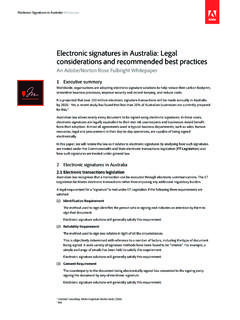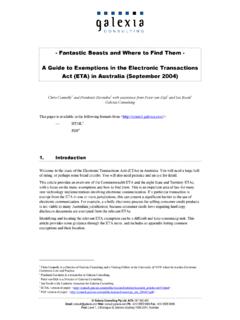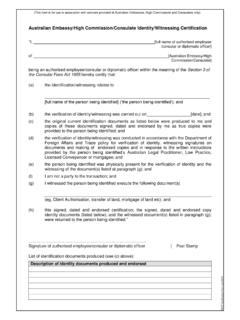Transcription of LOVE IS A MANY SPLENDORED THING. LOVE LIFTS US UP …
1 Screen Sound n4, 2013 love IS A many SPLENDORED THING. love LIFTS US UP WHERE WE BELONG. ALL YOU NEED IS love . Baz luhrmann s eclectic musical signature in the Red Curtain Trilogy Rebecca Coyle Abstract The following article addresses Baz luhrmann s use of musical elements to progress cinematic narrative in a spectacular, and often eclectic , manner. It examines how luhrmann layers various sonic elements to create a crowded musical extravaganza reminiscent of traditional stage productions (complete with red velvet curtain). A brief historical overview of luhrmann s career trajectory and his three Red Curtain Trilogy films is provided, including Strictly Ballroom (1992), Romeo + Juliet (1996) and Moulin Rouge!
2 (2001), followed by an analysis of how luhrmann s signature style of musical collage was developed. A comparison is then made of the narrative elements within the three films, and how these elements are used to construct a distinct branding strategy, resulting in the formation of the Red Curtain Trilogy. The article recognises the significance of repeated collaboration on the films production as an important facilitator of luhrmann s cinesonic style. It contributes a detailed discussion of specific musical choices and the reasoning behind them, with links to the use of music in cabaret and Bollywood. The article concludes with an orientation of the Red Curtain Trilogy within the local Australian industry.
3 Keywords Baz luhrmann , Moulin Rouge!, Romeo + Juliet, Strictly Ballroom, The Red Curtain Trilogy, branding, musical , spectacle, cabaret A love -it-or-hate-it experience, Moulin Rouge is all style, all giddy, over-the-top spectacle. But it's also daring in its vision and wildly Baz luhrmann s major feature films to date have achieved remarkable box office success although his approach to music has generated debate and 1 One of many ambivalent reviews published in response to Baz luhrmann s Moulin Rouge! and not unlike other reviews received in relation to the Red Curtain Trilogy. Sourced from: Screen Sound n4, 2013 10 criticism.
4 Yet, in his musical performance oeuvre, the music is an integral element of the impact, storylines and marketing of the films. luhrmann s eclectic mix of musical elements is driven by an auteurial approach to style, narrative and audience address. The auteur theory initially developed by critics associated with the French film review periodical Cahiers du Cin ma, and subsequently modified by Anglophone writers and academics, worked by detecting consistent themes, motifs and/or styles across a body of films made by the same While the identified consistency was routinely 'mapped' onto the individual who directed the films, the auteur proposed was as much a product of patterns of texts as s/he was an actual individual.
5 Recognition of this often-overlooked strategy of auteur theory is salient to considering the role of auteurial teams in creating the auteurial signatures frequently attributed to an individual director. Baz luhrmann draws on multiple styles and ideas to create his audiovisual texts, and his sonic approach adheres to a practice of eclecticism. The Oxford English Dictionary s definition of eclectic includes two significant elements: borrowed from various sources and made up of selections. 3 luhrmann s creative vision is heard both in the borrowed items he selects and in the ways they operate with the image track. The items themselves are critical components of his audiovisual texts, but, rather than attempt to reconcile the items apparently contrary styles, luhrmann actively intervenes in the texts to create a form of stylistic harmony.
6 luhrmann s style, as evident in the Red Curtain Trilogy, consciously brings together different approaches in a manner that goes beyond mere compilation and demonstrates the imposition of a creative audio-vision. In a definition of audio-vision , Michel Chion refers to sound working with image to supply at every moment a series of effects, sensations, and meanings . While often these are credited to the image and seem to emanate naturally from it, they nevertheless enhance the image with significant added value. 4 Regardless of the music s genre, luhrmann s intervention in it generates added value. This is what constitutes his approach: the anachronism and nostalgia in his screenplays and production design is interwoven with, and made integral to, the eclectic use of music.
7 This study of the Red Curtain Trilogy films (Strictly Ballroom, 1992; William Shakespeare s Romeo + Juliet, 1996; and Moulin Rouge!, 2001) provides an overview of musical components (including original cues, adapted existing music, pre-recorded numbers, sung items) to demonstrate the stylistic approach characteristically employed by luhrmann , and draws on production information that informs the textual analysis. The music track elements work around the diegesis, often in sequences centred on spectacles, thereby challenging designations of diegetic and non-diegetic film 2 See Andrew Sarris s Notes on the Auteur Theory in 1962 , in Film Culture, No.
8 27, Winter 1962 63 pp 515 518 as a seminal example, archived online at: 3 Little, W; Fowler, HW & Coulsen, J, The Shorter Oxford English Dictionary of Historical Principles, (3rd edn), Oxford: Clarendon, 1973, p. 627. 4 Michel Chion, Film, A Sound Art (trans. Claudia Gorbman), New York: Columbia University Press, 2003, p. 469. SSJ n4, 2013 Coyle : Baz luhrmann s eclectic musical signature in the Red Curtain Trilogy 11 music luhrmann s sonic style is identified in terms of his choices of music, the relationships of this music to his narratives, his manner of versioning music, and his strategies for marketing music. The elements that comprise his audio-vision developed from the upbringing, education, and experience on stage and screen in luhrmann s cultural background.
9 luhrmann on Stage and Screen Baz luhrmann s background in theatre critically informed his subsequent work and entr e into screen production. Born in 1962 as Mark Anthony luhrmann , Baz6 grew up in the small township of Herons Creek in northern New South Wales, Australia; he was raised by his mother, a ballroom dance teacher and dress shop owner, and his father, a farmer who also ran a petrol station and the local cinema. After childhood training in ballroom dancing and high school education in Sydney,7 luhrmann began his career: as an actor he appeared opposite Judy Davis in John Duigan s 1981 Australian feature film Winter of Our Dreams;8 and as co-director and performer he worked on the 1983 docu-drama Kids of the Cross.
10 luhrmann attended the prestigious National Institute of Dramatic Arts in Sydney and, in 1985, assisted on Peter Brooks production of the epic play The The next year luhrmann devised and staged the original Strictly Ballroom, a thirty-minute play that eventually won awards (for Best Production and Best director) at the World Youth Theater Festival in Bratislava, Slovakia (then Czechoslovakia). Also in 1986, for the New Moon Theatre Company, luhrmann directed Crocodile Creek, a musical theatre piece set and performed in the Australian outback. Following his graduation from the NIDA, luhrmann formed and served as artistic director for an independent theatre group called the Six Years Old Company; later he revived Strictly Ballroom for a successful season at Sydney s Wharf Theatre and a tour to the World Expo in Brisbane.






